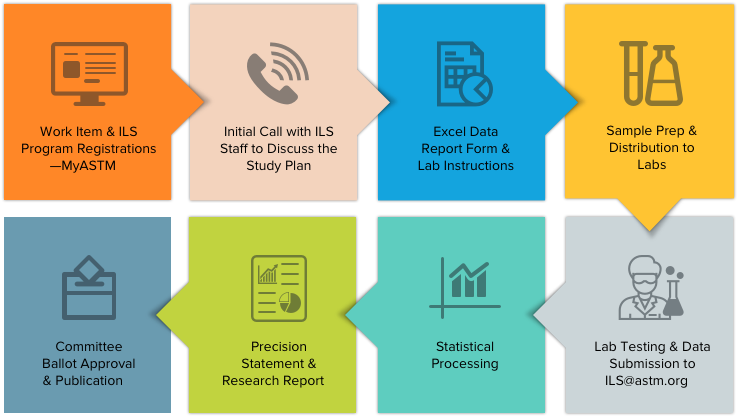Interlaboratory Study Program

The Interlaboratory Study Program is provided at no cost as a benefit for all ASTM members to help you meet the precision statement requirements in ASTM test methods.
The ASTM ILS Team is Ready to Assist
Developing a Precision and Bias statement using an Interlaboratory Study can be a complicated process, but our experienced team is here to help. Contact the ILS Team for assistance with:
- Designing an Interlaboratory Study
- Identifying potential samples
- Soliciting volunteer laboratories
- Finding an available supplier
- Ordering and purchasing samples
- Contracting with a distributor
- Reviewing laboratory instructions
- Shipping expenses
- Collecting data
- Analyzing data
- Producing a draft precision statement
- Compiling information for the Research Report
- Recognition of participating labs
Why Do You Need an Interlaboratory Study Program?
Precision and Bias in ASTM Test Methods
All ASTM standard test methods must include a precision and bias statement, per Section A.21 Form and Style for ASTM Standards. These statements strengthen the perceived quality of the standard test method. They also let users know that a test method has been laboratory tested.
The two measurements that serve to express precision in the evaluation of a standard test method are repeatability and reproducibility:
- Repeatability - addresses variability between independent test results gathered from within a single laboratory (otherwise known as intralaboratory testing)
- Reproducibility - addresses variability among single test results gathered from different laboratories (otherwise known as interlaboratory testing).
While Bias is defined as a systematic error that contributes to the difference between the mean of a large number of test results and an accepted reference value. When included in an ASTM test method, this statement describes the bias. It is important to remember that if an accepted reference value is not available, then the bias cannot be established. However, if the bias is unknown but the direction or bounds of the bias can be estimated, this information should be included in the bias statement.
Additional Information: Ruggedness Testing; Pilot Testing
We have created custom templates to assist you in drafting your Precision and Bias Statements:
Precision and Bias Template
Repeatability Precision Template
Interlaboratory Studies and Research Reports
Comprehensive interlaboratory studies are a key component in the development of a Precision and Bias statements. When an interlaboratory study is completed, it is important to document the details in a research report.
Per Section A29.1 of the ASTM Form and Style Manual, research reports are a requirement when numerical data is used to establish the precision and bias of a test method. Research Reports must include:
- a list of participating laboratories
- a description of samples tested
- a copy of the laboratory instructions
- the equipment/apparatus used
- a copy of the raw data
- a statistical summary
- a copy of the precision and bias statement
Our ILS team is here to help you when developing your Research Report. Contact us for assistance with general research report inquiries such as:
- generating research reports from ILS projects
- reformatting older reports to fit the ASTM Research Report Template
- obtaining research report numbers
Submitting Your Research Report
Once you’ve completed your full report, you will submit to our ILS team and it will be reviewed for completeness.
Once your ballot item is approved for adding your precision and bias statement to a test method, we’ll assign a new research report number. The published standard test method will include this number. Contact ASTM to request a copy of your research report.
How it Works – The Interlaboratory Study (ILS) Process
 Download the infographic: Interlaboratory Studies Program
Download the infographic: Interlaboratory Studies Program
- Register Your Work Item
- Register for Your ILS Program using your MyASTM area of the website.
- Conference Call ILS reps will schedule a call with the Technical Contact (TC). The TC should be prepared to discuss things like test specimens, lab supplies, potential suppliers, a distributor, a potential list of labs, and what data should be collected.
- Data Report Forms We’ll collect data using an excel data report form. The data report form will be sent to the TC for review before sending to the lab.
- Sample Distribution Once the study materials are secured, it may be necessary to send them to a distributor for final prep and packaging.The distributor will then ship the samples to the participating labs, and ASTM will send the data report forms and instructions.
- Data Submission ASTM will track data submitted by the lab participants.
- Statistical Summary Once all data is received, we will compute the repeatability and reproducibility using ASTM Statistical Software. Initial statistics and a draft precision and bias statement will be sent to the TC for review.
- Research Report (RR) ASTM will a draft research report for the TC to review.
- Precision and Bias Statement The precision and bias statement (along with any other revisions to the standard) should be placed on the next ballot.
- Approval After the ballot is approved and the research report is complete, ASTM will assign a Research Report number. Copies of the report will be sent to the TC and participating labs.
